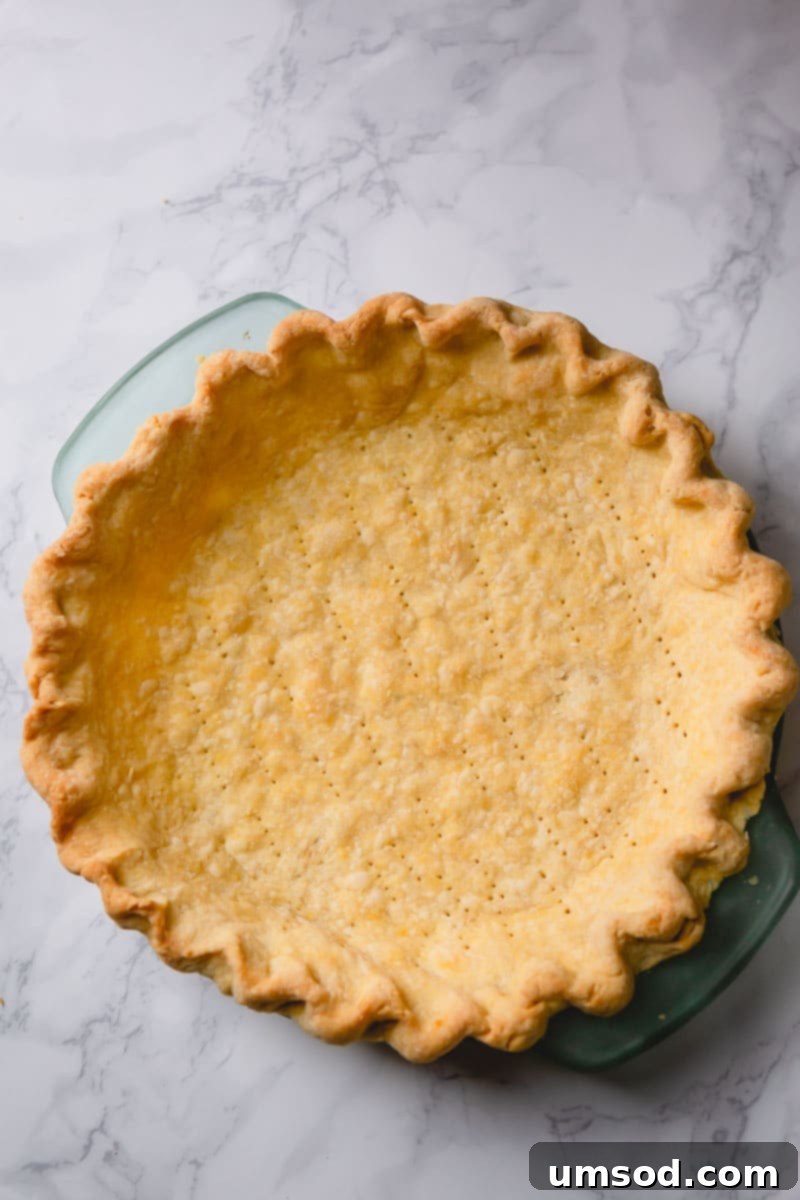Embark on a culinary journey to master the art of homemade pie with this meticulously crafted all-butter pie crust recipe. Time-tested and truly foolproof, this pie dough promises an unbelievably flaky, tender, and intensely flavorful foundation for all your sweet and savory creations. Prepare to transform your baking with a crust that’s not only super easy to make but consistently delivers perfection.
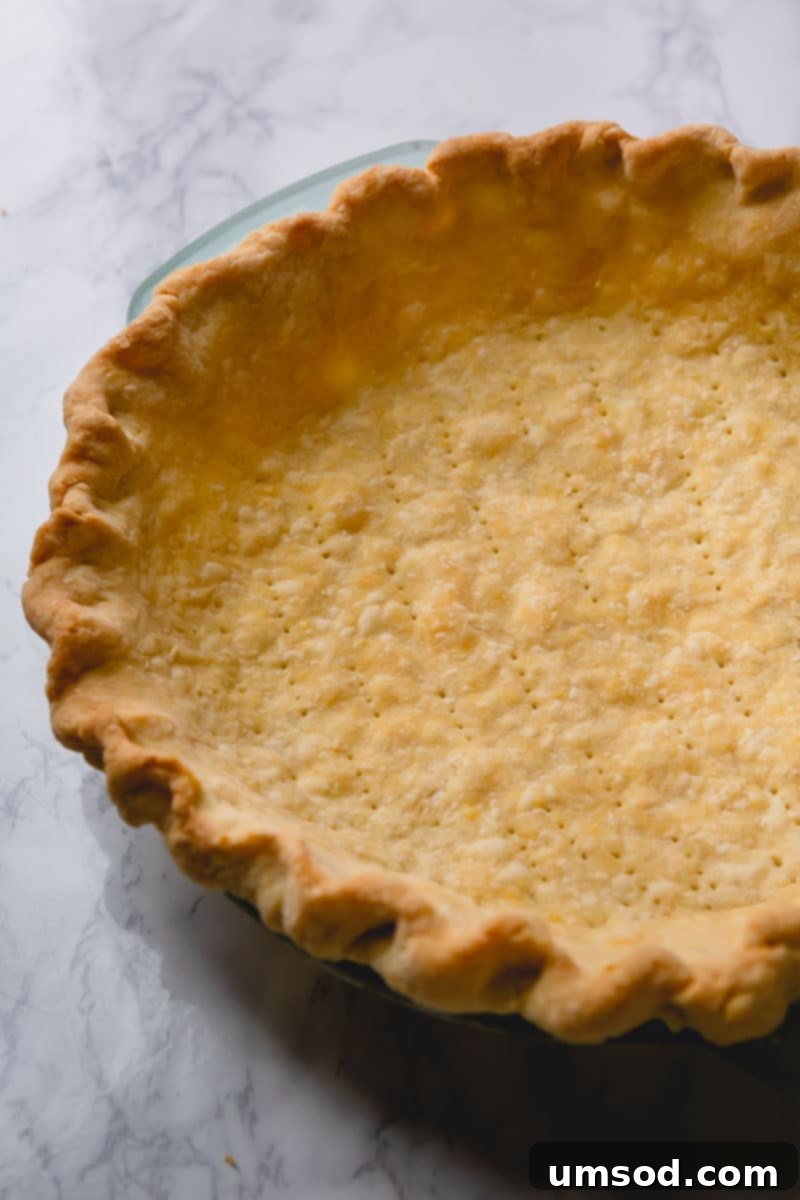
Every truly exceptional pie begins with an equally exceptional pie crust. It’s the silent hero, providing that delicate balance of flakiness, richness, and tenderness that cradles your favorite fillings. Imagine a crust that shatters with a gentle touch, melts in your mouth, and leaves behind a lingering taste of pure butter – that’s the dream, and it’s within your reach.
The culinary world is rich with countless “perfect” pie crust recipes, each with its own loyal following. From cherished family recipe cards passed down through generations to modern variations, the spectrum is vast. Some swear by all-shortening for crispness, others blend butter and shortening for a balance, while traditionalists prefer lard. You’ll find recipes advocating for a splash of vodka to inhibit gluten development, or simply relying on good old ice water. The variations are indeed endless, reflecting the diverse approaches to achieving this baking marvel.
Amidst this sea of options, I’m delighted to share my definitive all-butter pie crust recipe, refined over years of dedicated baking. This isn’t just a recipe; it’s a comprehensive guide packed with essential insights and practical tips. You’ll learn the secrets to successfully storing and freezing pie dough for extended periods, making holiday prep a breeze, and crucially, how to minimize the frustrating issue of shrinkage during baking.
My hope is that this guide will empower you to consistently bake pies that impress, making this very recipe your trusted, go-to foundation for years to come. Let’s unlock the secrets to the ultimate homemade pie crust together!
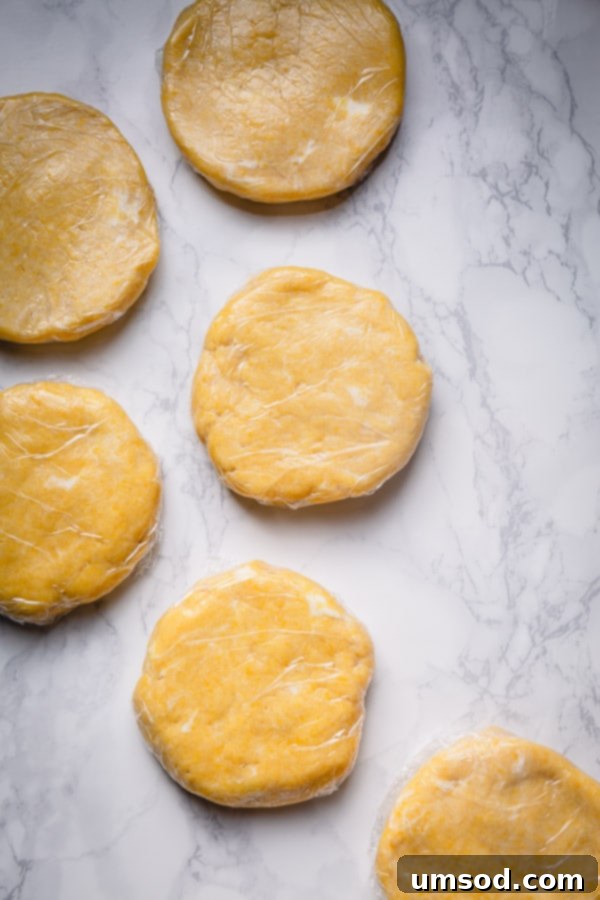
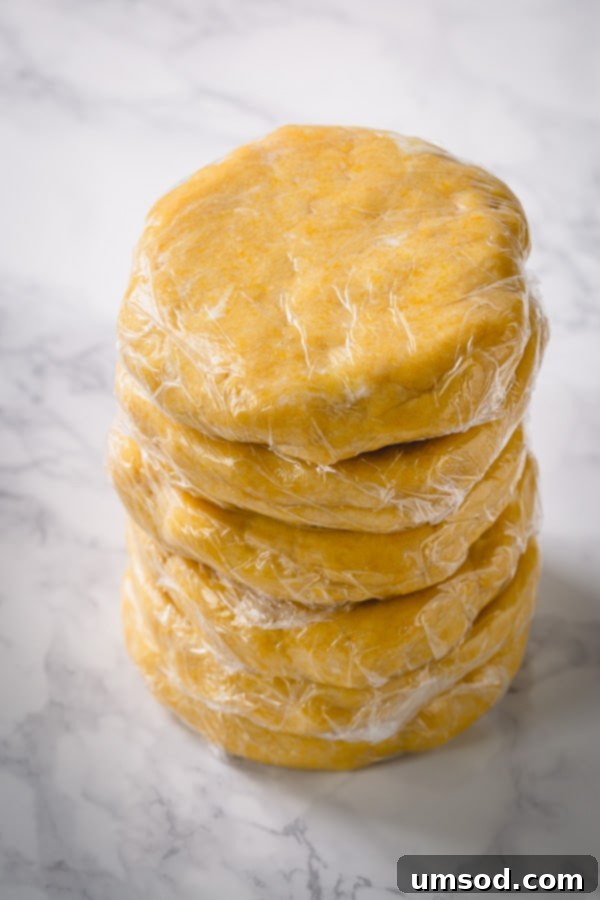
Why You’ll Fall in Love with This All-Butter Pie Crust Recipe
This recipe isn’t just another pie crust; it’s designed for maximum flavor, ease, and consistent results. Here’s why it will become your baking staple:
- Simple, Accessible Ingredients: True to its name, this pie dough relies solely on butter. This is a huge convenience for many home bakers who don’t typically keep shortening or lard on hand. While I have no aversion to other fats, using all butter simplifies the grocery list and ensures a universally loved flavor profile.
- Unbeatable Flavor & Richness: The secret weapon here is an egg yolk, which dramatically elevates the crust’s flavor and richness. It contributes to a beautiful golden hue and a more tender crumb, setting it apart from simpler recipes.
- Remarkably Easy to Make: Whether you’re a novice or a seasoned baker, this recipe is incredibly forgiving. I typically use my stand mixer for efficiency, but a simple pastry cutter (or even just your fingertips) will achieve the same fantastic results. The key lies in understanding a few basic principles, which I’ll guide you through.
- Incredibly Convenient & Versatile: This recipe is perfect for scaling. It’s super easy to double or even triple, making it ideal for double-crust pies, batch baking for holidays, or preparing ahead for impromptu dessert cravings.
With this reliable and foolproof method, you are guaranteed to achieve a wonderfully flaky, incredibly tender, and supremely flavorful pie crust every single time. Having perfected it over 8 years, I can confidently say this recipe delivers consistent success. Just follow my comprehensive tips below to ensure your pie baking ventures are always a triumph!
Key Ingredient Notes for Your Flaky Pie Crust
The quality of your ingredients directly impacts the quality of your pie crust. Understanding the role of each component is crucial for achieving the perfect texture and flavor.
- All-Purpose Flour: Opt for regular, unbleached all-purpose flour. Its moderate protein content (typically 10-12%) is ideal for developing just enough gluten for structure without making the crust tough. Higher protein flours, like bread flour, can lead to a chewy crust, while lower protein flours might result in a crumbly texture.
- Kosher Salt: This recipe calls for flaky kosher salt, which dissolves well and distributes flavor evenly, enhancing the overall taste of the crust. If you’re using fine table salt, remember to reduce the amount by half, as it’s much denser and saltier by volume.
- Unsalted Butter: Always choose unsalted butter for baking recipes unless otherwise specified. This allows you complete control over the salt content. If salted butter is all you have, simply omit the added salt from the recipe. Crucially, the butter must be very cold, ideally frozen, and cut into small cubes. This is fundamental for creating those desired flaky layers.
- Egg Yolk: The egg yolk is a game-changer for this all-butter crust. It enriches the dough, contributing to a deeper, more complex flavor and a beautiful golden color. Furthermore, the fat in the yolk helps tenderize the dough, preventing it from becoming too crisp and brittle.
- Ice Water: The importance of ice-cold water cannot be overstated. It is essential for keeping the butter solid and cold throughout the mixing process. Warm water will melt the butter, leading to a tough, dense crust instead of a flaky one.
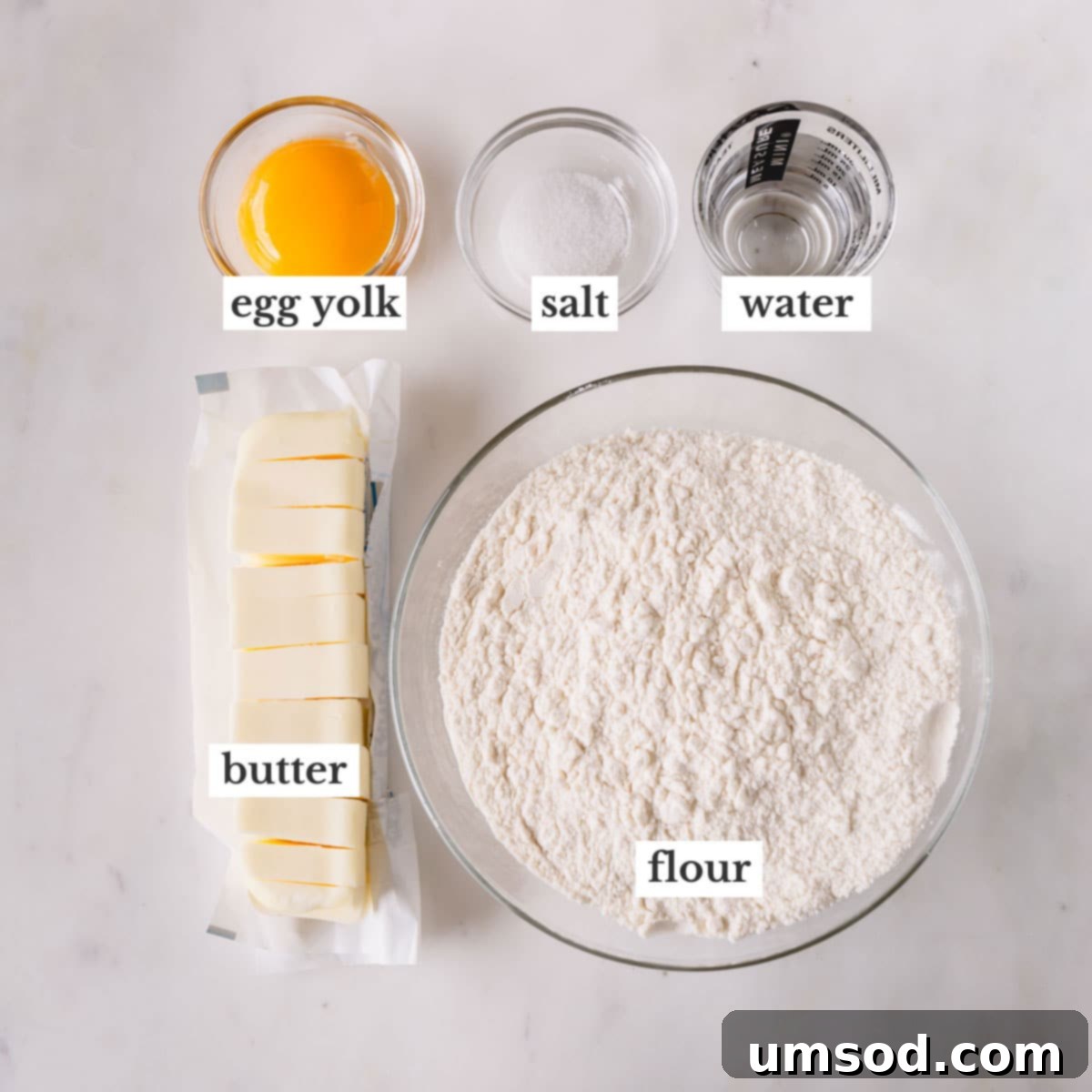
Understanding Flour: The Best Type for Pie Crust
The type of flour you use significantly impacts the final texture of your pie crust. With a protein content typically ranging from 10-12%, all-purpose flour is undeniably the best choice for crafting a tender and flaky pie crust. This moderate protein level allows for just enough gluten development to give the dough structure and elasticity without making it tough or chewy.
Flours with a higher protein content, such as whole wheat or bread flour, will form stronger gluten networks, resulting in a much tougher, more elastic, and less desirable pie crust. Conversely, very low protein flours, like cake flour, might produce a crust that is too tender and crumbly, lacking the necessary structure. Stick with unbleached all-purpose flour for consistent, superior results.
Butter vs. Shortening: Deciding on Your Pie Crust Fat
The age-old debate: which is superior for pie crust – all-butter or traditional shortening? It’s a question every pie baker eventually asks, and the answer largely depends on your priorities.
Here’s the truth: shortening-based pie dough excels at holding its shape, especially when you’re aiming for elaborate, intricate designs on your pie edges. Its higher melting point and lack of water content mean it’s less prone to spreading, allowing those carefully crafted flutes and patterns to remain crisp and defined after baking. Therefore, if your goal is an impressively decorative pie, a recipe incorporating shortening might be your best bet.
However, while an all-butter pie dough might result in a more “rustic” appearance – perhaps a slightly less precise crimp or a bit more spread – it offers an unparalleled advantage: flavor and texture. This butter pie dough delivers an extra tender, melt-in-your-mouth flakiness that shortening simply can’t replicate. Butter brings a rich, nuanced flavor that permeates every bite, creating a truly gourmet experience. So, while you’ll still achieve beautiful, albeit charmingly rustic, pies with this recipe, the superior taste and delicate texture make it a worthwhile choice for any pie enthusiast.
How to Make the Perfect All-Butter Pie Crust: Step-by-Step
As highlighted, crafting this delicious all-butter pie crust is surprisingly straightforward. I often double the recipe to have extra on hand, typically using my stand mixer for ease. Here’s a detailed breakdown of the process:
- Combine Dry Ingredients: In a large mixing bowl, combine your all-purpose flour and kosher salt. If using a stand mixer, attach the paddle attachment. If working by hand, use a pastry cutter or your fingertips. Mixing these first ensures even distribution of salt throughout the dough.
- Incorporate Butter and Egg Yolk: Add the frozen, cubed unsalted butter and the egg yolk to the flour mixture. Mix on the lowest speed (or use your pastry cutter/fingers) until the butter pieces are roughly the size of small peas or flattened almonds. It’s crucial not to overmix at this stage; visible pieces of butter are key to flakiness. The egg yolk will start to bind slightly with the flour.
- Add Ice Water Gradually: Begin adding the ice water, one tablespoon at a time, mixing briefly after each addition. The exact amount of water can vary based on humidity and flour type, so observe the dough carefully. Continue adding water until the dough just starts to come together into large, shaggy clumps that stick when squeezed. Stop immediately when this consistency is reached – too much water will make the dough sticky and tough.
- Gather the Dough: Gently turn the shaggy dough out onto a clean, lightly floured counter. Using your hands, quickly gather the dough into a cohesive ball. Handle it as little as possible to avoid overworking the gluten and warming the butter.

- Form and Chill: Flatten the dough ball into a round disk, approximately 1-inch thick. This shape will make rolling it out later much easier. Tightly wrap the disk in plastic wrap and refrigerate for at least 1 hour. Chilling is a critical step that allows the gluten to relax and the butter to firm up again, both essential for a tender, flaky, and easy-to-roll crust.


Essential Tips for a Flawless All-Butter Pie Crust
Achieving pie crust perfection is within reach if you adhere to these crucial tips:
- Weigh Your Flour: While not strictly mandatory, I strongly advocate for weighing your flour using a kitchen scale rather than measuring by volume. This ensures the most accurate ratio of dry to wet ingredients, which is paramount for consistent results. A cup of flour can vary significantly in weight depending on how it’s packed.
- Freeze Your Butter: Cut your very cold butter into small, ½-tablespoon cubes and freeze it for at least 30 minutes before incorporating it into the flour. Keeping the butter as cold and solid as possible is the primary secret to creating those desirable flaky layers during baking.
- Avoid Over-Mixing: Over-mixing is the enemy of a tender pie crust. It develops gluten excessively, leading to a tough, chewy texture. Mix just until the dough comes together. A helpful trick: cubing the butter into smaller, uniform pieces (around 1/4 tablespoon) helps distribute the fat more evenly and reduces the need for prolonged mixing.
- Utilize Ice Cold Water: Always use ice-cold water, or even ice water with a few small ice chips, to mix your dough. This prevents the butter from melting, ensuring it remains in distinct pieces throughout the dough. Maintaining a cold dough temperature is vital for flakiness.
- Add Water Incrementally: Introduce the ice water one to two tablespoons at a time, pausing to mix and assess the dough’s consistency. This careful approach prevents you from inadvertently adding too much liquid, which can result in a sticky, unmanageable dough that’s difficult to roll out and prone to toughness.
Using Your Homemade Pie Dough
Once your pie dough has properly chilled, it’s ready to be transformed into a delicious pie or pastry.
If your pie dough has been frozen, remember to thaw it slowly in the refrigerator overnight for best results. Once thawed, bring it out onto the counter for about 30-45 minutes before you plan to roll it out. This allows the butter to soften just enough to be pliable without becoming greasy, preventing cracks while rolling.
This versatile all-butter pie dough is perfect for any kind of pie, from classic fruit pies to rich cream pies, and even individual turnovers. Imagine crafting delectable apple pie turnovers or charming mini strawberry pies, all starting with this incredible foundation.
The Science of Flakiness: Why Cold is Crucial for Pie Dough
You might be wondering why every instruction for pie crust emphasizes “cold butter” and “ice water.” The answer lies in the science of flakiness, a concept closely related to the laminating technique used in making flaky croissants.
It is absolutely vital to use cold butter and ice water because our goal is not to fully melt or integrate the butter into the dough. Instead, we want to create numerous small, distinct chunks or “pockets” of butter distributed throughout the flour mixture. When these butter pieces hit the hot oven, the moisture within the butter rapidly turns into steam. This steam then forces apart the layers of dough around the butter, creating those magnificent, airy, and distinct flaky layers that are the hallmark of an exceptional pie crust.
If the butter melts prematurely during mixing, it will be absorbed by the flour, leading to a homogenous, short dough that becomes tough and dense rather than flaky. So, don’t be alarmed if you see small swirls and chunks of butter visible in your pie dough after mixing and chilling – this is precisely what you want to see! It’s a sure sign that you’re on your way to achieving the most tender, melt-in-your-mouth flaky crust possible.
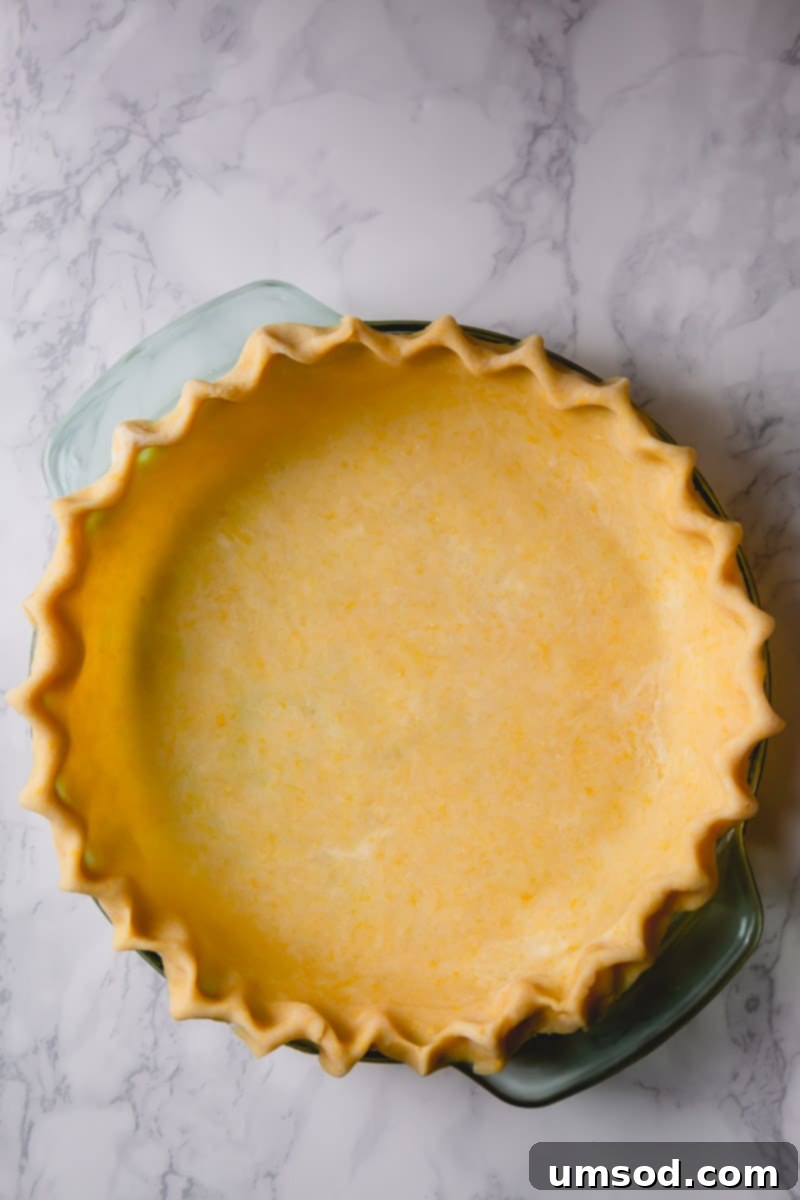
Crafting Simple, Elegant Pie Dough Edges
When it comes to finishing a pie, I often lean towards a simpler, more rustic approach rather than elaborate, intricate designs. The beauty of a homemade pie often lies in its charming imperfections!
Let me share my straightforward method for crimping pie crust edges. Unlike many recipes that instruct you to trim away excess dough, which can feel wasteful, I prefer to utilize all the dough for a thicker, more substantial border. Simply ensure you don’t roll out an excessively large circle to begin with.
Here’s how I create my classic crimped edge:
- Fold and Roll the Edges: Once your rolled-out dough is carefully draped into the pie dish, gently fold the excess dough outwards, tucking it under itself until the folded edge meets the rim of the pie dish. Carefully roll and press this folded edge to create a nice, thick border. This won’t be perfectly uniform all the way around – some sections might be slightly thinner or thicker – but that’s perfectly fine and adds to its homemade charm.
- The Three-Finger Crimp: With your border established, use a simple three-finger method to crimp the edges. Place your index finger from one hand on the inside of the rim, and then pinch the dough with the thumb and index finger of your other hand from the outside. Repeat this motion all the way around the pie, creating a beautiful, classic, and timeless fluted edge, as demonstrated in the image below.

Mastering Shrinkage Control: Tips for an All-Butter Pie Crust
As previously mentioned, pie crusts made with shortening tend to hold their intricate shapes more resolutely due to shortening’s higher melting point and stability. It’s true that all-butter crusts, while superior in flavor and flakiness, can sometimes be more prone to shrinking during baking, especially when adorned with delicate, carefully designed edges.
However, fear not! There are highly effective strategies to significantly minimize, if not entirely prevent, this annoying shrinkage issue, ensuring your beautiful crust remains intact.
Key Strategies to Minimize Pie Crust Shrinkage
- #1 Key: Adequate Chilling and Resting: This is the absolute most critical step to avoid shrinkage. After you’ve rolled out your dough, placed it in the pie dish, and meticulously crimped the edges, it is imperative to chill the pie crust again before baking. Place the entire pie dish, with the crimped crust, into the refrigerator for at least 30 minutes, or even longer while you prepare your pie filling. The longer it chills, the better. This resting period allows the gluten strands, which become stretched during rolling, to relax. It also ensures the butter firms up again, providing structure as the crust enters the oven.
- Crimp Over the Lip of the Dish: When crimping your pie edges, make sure to form the crimps over the very edge or lip of your pie dish, rather than inside the wall of the dish. This extra overhang acts as an anchor, giving the dough something to cling to as it bakes and tries to pull back, effectively reducing shrinkage.
By diligently following these two principles, you’ll dramatically improve the structural integrity of your all-butter pie crust, allowing those flavorful, flaky edges to hold their ground beautifully.
Maximizing Convenience: How to Store Your All-Butter Pie Dough
Having extra pie dough on hand is never a drawback; in fact, for me, it’s an absolute necessity, especially as the busy holiday season approaches! Preparing pie dough in advance saves invaluable time and reduces stress.
Your freshly made pie dough can be refrigerated for up to 3 days. Simply ensure it’s tightly wrapped in plastic wrap to prevent it from drying out or absorbing any odors from the fridge. For longer storage, freezing is your best friend. Properly frozen pie dough can last for up to 3 months, offering incredible flexibility.
Two Effective Methods to Freeze Your Pie Dough:
- Method #1: Freezing Dough Discs: This is ideal for maximum freezer space efficiency.
- After forming your dough into a flattened disc and wrapping it tightly in plastic wrap (double wrap if freezing for over a month for extra protection against freezer burn), place it in a freezer-safe bag.
- Label the bag with the date and freeze for up to 3 months.
- To Use: When you’re ready to bake, simply transfer the frozen pie dough disc to the refrigerator overnight to thaw. Once thawed, let it sit at room temperature for 30-45 minutes before rolling.
- Method #2: Freezing in the Pie Dish (Blind-Baked Ready): Perfect for ultimate convenience, especially for pies that require blind baking.
- Roll out your chilled pie dough and carefully lay it into your pie dish. Crimp the edges as desired.
- Wrap the entire pie dish, with the crust inside, first in a layer of plastic wrap, then snugly in aluminum foil to protect it.
- Freeze for up to 3 months. Be sure to place it in a spot where it won’t get squished or jostled by other items in the freezer; an upright freezer can be particularly useful for this method.
- To Use: When it’s time to bake, you can take this pre-formed, frozen crust straight from the freezer and proceed directly to blind-baking, saving you precious time.
How to Blind Bake a Pie Crust for Crisp Perfection
Certain pie recipes, such as my exquisite lemon meringue pie, comforting pecan pie, or creamy banana cream pie, require a pre-baked or “blind-baked” crust. This means the crust is partially or fully cooked without its filling, ensuring a crisp base that won’t become soggy from wet fillings.
Here’s how to perfectly blind bake your all-butter pie crust:
- Prepare the Crust for Baking: After your pie crust has been formed in the dish and chilled (as per the shrinkage prevention tips), gently place a sheet of aluminum foil directly over the crust, molding it to fit the contours of the pie. Fill the foil-lined crust with pie weights. If you don’t have dedicated pie weights, raw beans or rice work perfectly well (note: these beans/rice should not be cooked or consumed after being used as pie weights). The weights prevent the crust from puffing up and shrinking during baking.
- Initial Bake with Weights: Place the weighted pie crust in a preheated 350°F (175°C) oven and bake for 15 minutes. This initial bake helps set the structure of the crust.
- Remove Weights and Pierce: Carefully remove the pie weights and the aluminum foil. Using a fork, generously pierce the bottom and sides of the crust all over. This “docking” process is vital for allowing steam to escape, which prevents the crust from forming uneven bubbles or large air pockets during the final bake.
- Final Bake to Golden Brown: Return the crust to the oven and bake for another 10-15 minutes, or until the crust is beautifully golden brown and appears dry and crisp. The exact time will depend on your oven and desired level of doneness.
Save this incredible all-butter pie crust recipe now and elevate your baking game. Don’t forget to leave a review once you give it a try and experience the difference!
All-Butter Pie Crust Recipe FAQs
The terms “pie dough” and “pastry dough” are often used interchangeably, as both are generally made with flour, fat, and liquid. However, “pastry dough” is a broader term that can include variations like puff pastry (made by laminating butter into dough for many flaky layers), choux pastry, or shortcrust pastry. Pie dough typically refers to a type of shortcrust pastry designed specifically for pie shells.
Pie crust is a type of shortcrust pastry. It’s a rich, unleavened dough made by cutting cold fat (like butter, shortening, or lard) into flour, then binding it with a small amount of ice water. This method creates a tender, crumbly, and flaky texture when baked.
The ultimate secret to a truly good, flaky pie crust is using very cold butter and handling the dough minimally. Keeping the butter frozen and in distinct pieces within the dough ensures that these small pockets of fat melt in the oven, releasing steam and creating airy, separated layers. It’s crucial to maintain a cold dough temperature throughout the process to prevent the butter from melting prematurely.
Yes, often pie and tart dough can be made from the same basic recipe, especially a standard shortcrust pastry. However, tart dough (or pâte sucrée/pâte sablée) can sometimes be richer with added sugar or egg yolks, making it more cookie-like and less prone to shrinkage, specifically designed for decorative tarts. For many home bakers, a good pie dough recipe works beautifully for both.
No, there is generally no need to spray a pie pan with cooking spray when making a standard pie crust. The high fat content of the butter in the crust itself usually provides enough lubrication to prevent sticking. In fact, spraying can sometimes make the crust overly greasy or inhibit crispness.
Yes, when blind baking a pie crust (baking it without filling), it is essential to prick the bottom and sides of the crust thoroughly with a fork. This process, known as “docking,” allows steam to escape during baking, preventing the crust from puffing up unevenly or forming large air pockets that would distort its shape and make it difficult to fill.
Watch Our Video: How to Make Flaky All-Butter Pie Dough
More Delicious Pie Recipes You’ll Adore
Now that you’ve mastered the art of the perfect pie crust, put your skills to good use with these delightful pie and tart recipes from our collection:
- Elegant Pear Tarte Tatin
- Creamy Homemade Banana Cream Pie
- Classic Lemon Meringue Pie
- Quintessential Sweet Cherry Pie
- The Best Classic Pecan Pie

All-Butter Pie Crust
Shinee Davaakhuu
15
30
1 30
2 15
1 9-inch single-crust pie dough
Comment
Print Recipe
Ingredients
- 1 ½ cups (190 g) all-purpose flour
- ¼ teaspoon kosher salt
- ½ cup (113 g) unsalted butter cut into ½ tablespoon pieces and frozen
- 1 (17 g) egg yolk
- 3-4 tablespoons (45-60 ml) ice water
Instructions
- To make the pie dough: In a large mixing bowl with a paddle attachment (or using a pastry cutter), mix together the flour and salt until well combined.
- Add the frozen butter cubes and egg yolk to the flour mixture. Mix on the lowest or stir speed until the butter pieces are about pea-size. Be careful not to overmix; visible butter chunks are desired.
- Add ice water one tablespoon at a time, mixing briefly after each addition, until the dough just starts to come together and forms into a loose ball or large clumps. Depending on humidity, you may not need all the water or might require an extra tablespoon or two. The goal is for the dough to stick together when squeezed. Avoid adding too much water, as this will result in a sticky, difficult-to-work-with dough. Tip: Don’t be alarmed by small pieces or swirls of butter in the dough – this is exactly what contributes to a tender and flaky crust as these butter pieces will melt and create steam during baking.
- Turn the dough out onto a lightly floured counter. Quickly gather and form it into a ball, then flatten it into a disk about 1-inch thick. Wrap it tightly in plastic wrap and refrigerate for at least 1 hour, or up to 3 days. For longer storage, place the wrapped disk in a freezer bag and freeze for up to 3 months.
- To blind bake a pie crust: Once chilled, roll the pie dough into a 10 to 11-inch circle on a lightly floured surface. Carefully wrap the dough around your rolling pin and transfer it onto your baking pan. Fold the edges out and roll them until they meet the pie pan’s rim. Crimp the edges using your preferred method, or follow the simple three-finger technique shown above.
- Place the prepared crust in the fridge for at least 30 minutes to chill thoroughly. This step is crucial for preventing shrinkage.
- Meanwhile, preheat your oven to 350°F (177°C).
- Cover the chilled crust with a sheet of aluminum foil, gently molding it to the shape of the pie. Pour pie weights (or raw beans/rice – note: do not use these beans for cooking after they’ve been used as pie weights) into the foil-lined crust to keep it from puffing up.
- Bake for 15 minutes with the weights. Then, carefully remove the foil and pie weights. Using a fork, pierce holes all over the bottom and sides of the crust to prevent any remaining bubbles and air pockets from forming. Bake for another 10-15 minutes, or until the crust is beautifully golden brown and appears crisp.
⭐️ Did you make this recipe?
Please leave a review and let us know how you liked it!
Tips & Notes
This versatile recipe can be easily doubled or tripled to prepare multiple pie crusts, perfect for double-crust pies or ahead-of-time holiday baking.
Nutrition

This recipe was originally published on January 6th, 2013, and last updated on November 19, 2020.
